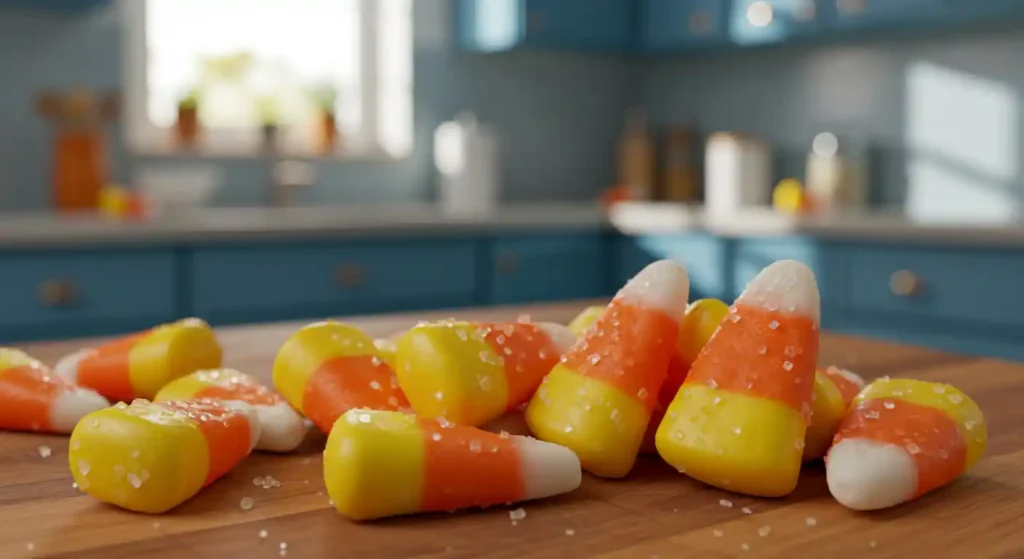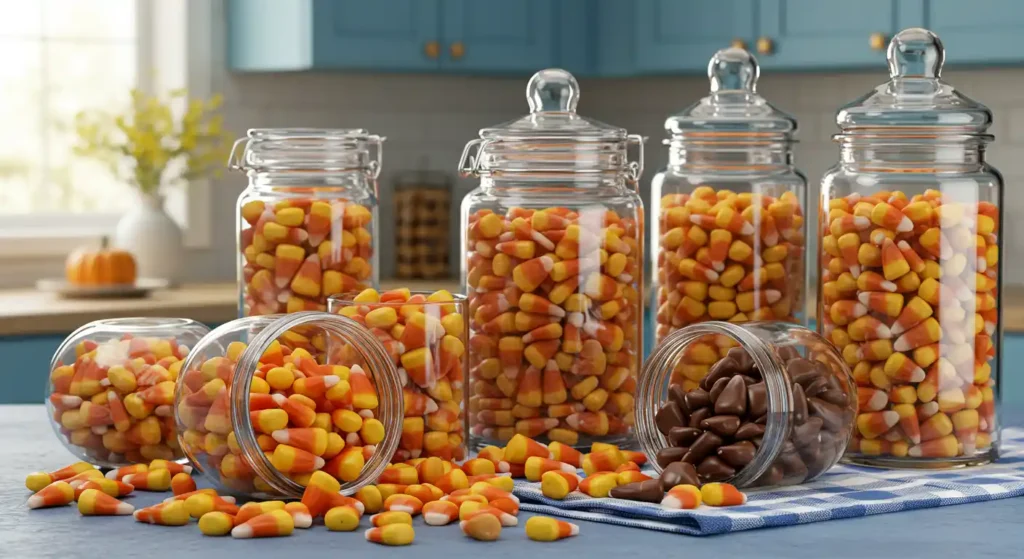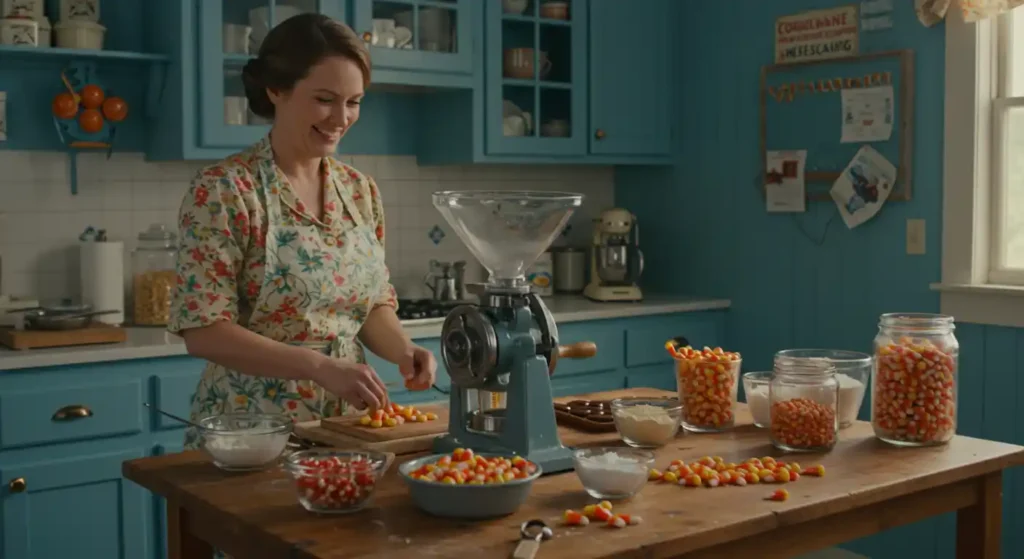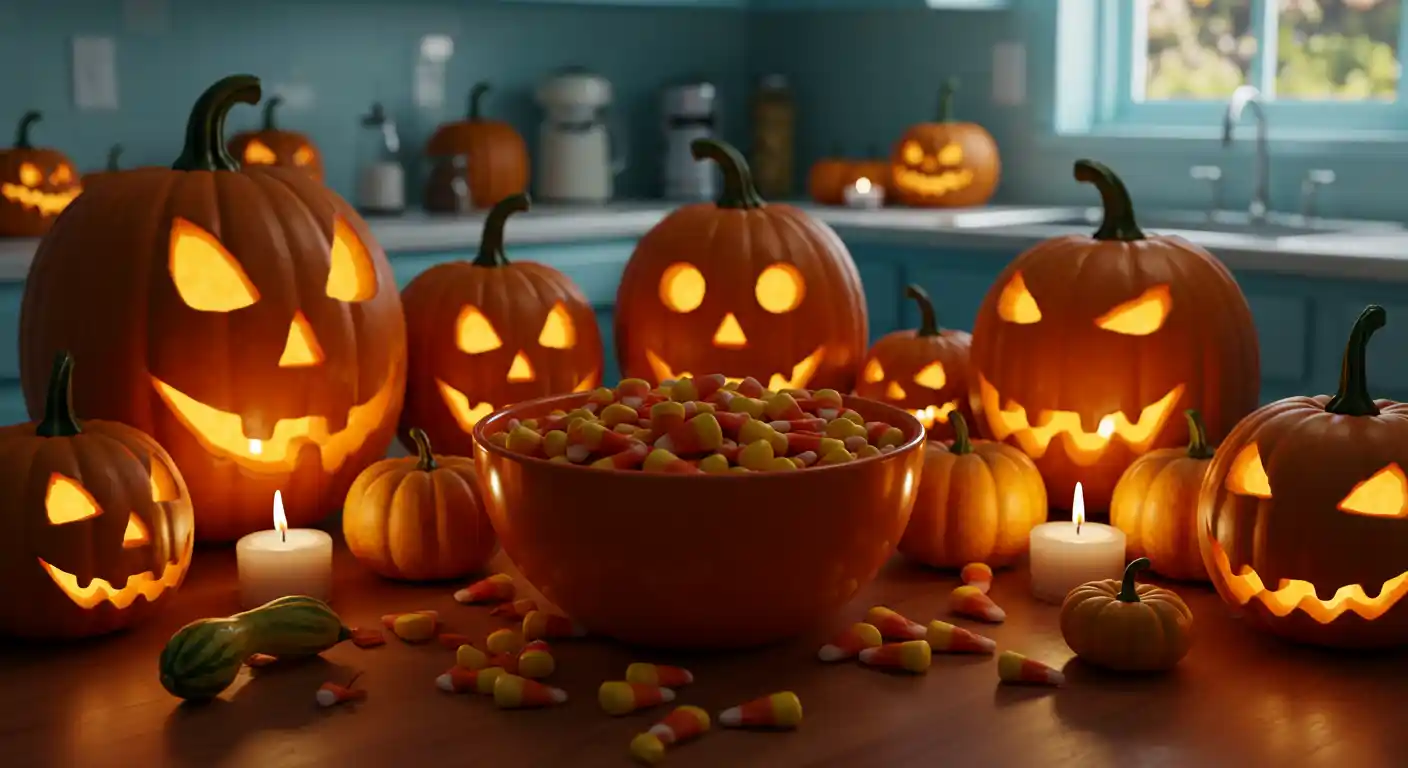Introduction to Candy Corn
Candy corn, with its vibrant yellow, orange, and white hues, has become a quintessential symbol of Halloween in the United States. Known for its sweet, creamy flavor and waxy texture, this tri-colored candy has been a seasonal favorite for over a century. But what makes candy🍬 corn so iconic, and why does it continue to spark both nostalgia and controversy among candy enthusiasts?
The Origin of Candy Corn
Candy🍬 corn was invented in the late 19th century by George Renninger, a confectioner at the Wunderle Candy Company. Inspired by the agrarian lifestyle of the time, the candy’s design mimicked a kernel of corn—a staple crop and symbol of harvest in America. The original recipe was a labor-intensive mixture of sugar, corn syrup, and marshmallow, poured into kernel-shaped molds by hand. Its name and design were a tribute to its resemblance to actual corn kernels, which held significant cultural importance.
Evolution of Candy Corn Over the Decades
In its early days, candy🍬 corn was marketed as “chicken feed” to appeal to rural consumers, complete with a rooster on the packaging. Over time, production became more automated, allowing companies like Goelitz Confectionery Company (now Jelly Belly) to meet growing demand. Today, millions of pounds of candy🍬 corn are produced annually using modern techniques, but the basic recipe and nostalgic appeal remain largely unchanged.
Candy Corn and Its Seasonal Popularity
While candy🍬 corn is available year-round, its association with Halloween has cemented its status as a seasonal treat. Its harvest-themed colors perfectly align with autumn celebrations, and its simplicity makes it a staple in Halloween candy bowls across the nation. Beyond the original, variations like caramel, chocolate, and even fruity flavors have emerged, further expanding its appeal.
Nutritional Profile of Candy Corn
Candy🍬 corn may be a fun and colorful treat, but it’s worth taking a closer look at its nutritional makeup. Made primarily of sugar and corn syrup, this sweet confection isn’t exactly a health food, but it holds its own as a nostalgic indulgence.
Ingredients Breakdown:
Candy corn’s base is a simple blend of sugar, corn syrup, and confectioner’s glaze, combined with flavorings and food coloring. These ingredients are what give it its signature sweetness and slightly waxy texture. Some recipes include gelatin or honey for added chewiness.
Calorie Count and Serving Size:
A serving size of candy🍬 corn (about 19 pieces or 28 grams) contains approximately 140 calories. This serving also delivers 28 grams of sugar, which is almost the entire recommended daily intake for adults. For those mindful of their sugar consumption, candy corn is best enjoyed in moderation.
Are There Any Health Concerns?
Given its high sugar content, candy🍬 corn can contribute to cavities and spikes in blood sugar levels if consumed in large quantities. It’s also worth noting that some varieties contain artificial dyes or flavorings, which may be a concern for individuals with sensitivities. However, as a once-a-year indulgence, it can fit into most diets without major issues.
The Debate: Love It or Hate It?
Candy corn is arguably one of the most polarizing candies out there. People seem to either adore it or avoid it like the plague—there’s rarely an in-between.
Why Some People Love Candy Corn:
For many, candy🍬 corn evokes warm memories of Halloween celebrations, trick-or-treating, and autumn festivities. Its unique texture and sugary taste provide a comforting familiarity, and its vibrant colors brighten any candy dish.
Reasons for the Dislike Among Others:
On the flip side, critics often cite candy corn’s overly sweet flavor and waxy texture as off-putting. Some even describe it as “too artificial” or lacking the complexity found in other confections. This divide has made candy🍬 corn a frequent topic of debate on social media and in pop culture.
Pop Culture References and the Debate’s Impact on Its Popularity:
Despite—or perhaps because of—its controversial status, candy🍬 corn remains a beloved Halloween icon. Its polarizing nature only adds to its intrigue, with memes, debates, and even candy🍬 corn-themed merchandise keeping it relevant year after year.
DIY Candy Corn Recipes
For those who want to take their candy🍬 corn love to the next level, making it at home can be a fun and rewarding activity. With a little patience and creativity, you can craft your own batch of candy🍬 corn from scratch.
How to Make Candy Corn at Home:
Homemade candy🍬 corn requires just a few ingredients: powdered sugar, corn syrup, butter, vanilla extract, and food coloring. Start by heating the sugar, corn syrup, and butter until smooth, then mix in the dry ingredients. Once the dough cools, divide it into three portions, add coloring, and roll it into ropes before cutting into pieces, For more homemade treats, For more homemade treats, check out our Homemade Protein Brownies Recipes
Creative Uses in Desserts and Snacks:
Candy🍬 corn isn’t just for snacking—it can also be used as a decorative element in baked goods. Try topping cupcakes, cookies, or even a Halloween-themed cake with candy🍬 corn for a festive touch. It also works well in snack mixes when paired with popcorn, pretzels, and nuts.
Kid-Friendly Activities Involving Candy Corn:
Get the kids involved by using candy🍬 corn for crafting or decorating. Create edible necklaces, candy🍬 corn mosaics, or even use them to top caramel apples. It’s a hands-on way to make Halloween even more memorable.

Marketing and Branding of Candy Corn
The success of candy corn isn’t just about its taste—smart marketing has played a huge role in its enduring popularity.
Famous Brands and Their Contributions:
Brands like Brach’s have become synonymous with candy corn, dominating the market with their classic recipes and seasonal varieties. Other companies have introduced unique twists, such as chocolate-tipped or fruit-flavored versions, keeping the candy fresh and exciting.
The Role of Advertisements in Its Enduring Fame:
From vintage posters to modern-day social media campaigns, candy corn has consistently been marketed as a nostalgic and essential part of Halloween. These campaigns often tap into its iconic imagery and appeal to both young and old alike.
Limited-Edition and Holiday-Themed Packaging:
To keep consumers engaged, manufacturers frequently release limited-edition versions of candy-corn, such as Christmas or Easter-themed varieties. These seasonal adaptations ensure that candy-corn remains a year-round fixture in the candy aisle.
Interesting Facts About Candy Corn
- Candy Corn’s Longevity: First produced in the 1880s, candy corn has been around for well over a century, making it one of the oldest mass-produced candies in America.
- Production Numbers: Each year, over 35 million pounds of candy corn are produced—enough to circle the moon if laid end to end!
- Global Reach: While it’s predominantly a North American treat, candy🍬 corn has also found fans in countries like Canada and Australia, albeit on a smaller scale.
How to Incorporate Candy Corn in Everyday Life
Candy corn’s versatility extends beyond Halloween—it can add a touch of fun and sweetness to various aspects of daily life. From decorations to recipes, this colorful candy can be more than just a seasonal indulgence.
Decorations with Candy Corn:
Candy corn’s bright colors make it a perfect addition to seasonal décor. Fill clear jars or vases with candy🍬 corn to create eye-catching centerpieces for your dining table or mantel. You can also use it in DIY wreaths or garlands for a festive touch.
Candy Corn-Inspired Recipes:
From candy🍬 corn popcorn balls to layered candy corn parfaits, the possibilities are endless. You can even use the candy to create candy🍬 corn bark—a mix of melted chocolate, crushed candy🍬 corn, and pretzels for a sweet and salty treat. These recipes are perfect for parties or as gifts during the Halloween season.
Non-Edible Uses for Candy Corn:
Not everything candy corn does has to be about eating. Use it for educational games, like counting exercises for kids, or include it in art projects like mosaic-making. These activities let you enjoy candy🍬 corn without consuming too much sugar.
Environmental Concerns and Sustainability
As delightful as candy corn may be, it’s important to consider the environmental impact of its production and packaging. Like many candies, candy corn typically comes in single-use plastic packaging, which contributes to global waste.
Packaging Waste Issues:
The widespread use of non-recyclable plastic in candy🍬 corn packaging presents a significant environmental challenge. These materials often end up in landfills or oceans, posing risks to wildlife and ecosystems.
Efforts to Create Eco-Friendly Alternatives:
Some candy manufacturers are experimenting with biodegradable or recyclable packaging to reduce their ecological footprint. As consumers, supporting brands that prioritize sustainability can make a big difference.
The Role of Consumers in Reducing Waste:
Simple actions like reusing candy🍬 corn packaging for crafts or purchasing in bulk to minimize waste can contribute to more sustainable consumption. Advocating for better packaging practices within the candy industry is another way to make a positive impact.
The Future of Candy Corn
Candy corn has stood the test of time, but what does the future hold for this iconic treat?
Predictions for Trends:
With the rise of health-conscious consumers, we might see a shift toward low-sugar or sugar-free candy🍬 corn options. There’s also potential for more organic and all-natural varieties to cater to changing tastes.
The Rise of New Flavors:
Manufacturers have already begun experimenting with unique flavors, from s’mores to apple pie. Expect even more creative innovations as companies strive to keep candy corn relevant to younger generations.
What the Candy Industry Says About Its Future:
Despite its polarizing nature, candy🍬 corn remains a profitable product for candy makers. Industry leaders predict it will continue to be a staple of seasonal celebrations, albeit with modern twists to appeal to evolving consumer preferences.
Candy Corn Around the World
While candy corn is undeniably a quintessential American treat, it has gradually started making its mark across international borders. Though not as widely celebrated in other countries, its novelty and vibrant appearance have garnered curiosity and interest abroad.
International Perception:
In countries like Canada, the UK, and Australia, candy corn has developed a niche following. American-themed stores and online retailers often stock candy🍬 corn during the Halloween season, introducing it to international audiences who are intrigued by its history and association with U.S. traditions.
Adaptations in Other Cultures:
To cater to diverse palates, some international confectioners have reimagined candy corn with local twists. For instance, tropical fruit-flavored versions have emerged in some regions, while others have adopted unique packaging and marketing strategies to suit their cultural preferences.
Candy Corn in Pop Culture
Candy corn’s status as a Halloween staple has secured its place in pop culture, making appearances in films, TV shows, and even internet memes. Its vibrant colors and distinct design have become an enduring symbol of fall festivities.
Famous Appearances:
Movies like Hocus Pocus and shows like The Simpsons have included candy🍬 corn in their Halloween-themed episodes, showcasing it as a visual cue for seasonal cheer. Its iconic status ensures it frequently appears in decorations, party scenes, and holiday montages.
Memes and Social Media:
The ongoing debate over candy corn’s appeal has inspired countless memes and jokes on social media platforms. Whether praising its nostalgic charm or poking fun at its divisive flavor, candy🍬 corn consistently sparks lively online discussions.
The Role of Candy Corn in Celebrations Beyond Halloween
Though Halloween is its peak season, candy🍬 corn has also found its way into other holidays and celebrations, thanks to its versatility and adaptability.
Thanksgiving and Harvest Festivals:
Candy corn’s harvest-inspired colors—yellow, orange, and white—make it a fitting choice for Thanksgiving celebrations. It often appears in centerpieces, snack mixes, and baked goods during fall gatherings.
Specialty Varieties for Other Holidays:
Manufacturers have introduced holiday-themed variations to extend candy corn’s seasonal relevance. Red, green, and white candy🍬 corn varieties brighten Christmas displays, while pastel versions add charm to Easter celebrations. These adaptations ensure candy corn remains a year-round treat for those who love it.

How Candy Corn Is Made
For candy lovers curious about the creation process, the production of candy🍬 corn offers a fascinating glimpse into confectionery artistry. Though technology has modernized its manufacturing, the core steps remain true to its original craftsmanship.
Step-by-Step Production:
Candy corn starts with a heated mixture of sugar, corn syrup, and other ingredients, which is carefully poured into kernel-shaped molds. The process involves layering the candy in its signature colors—white, then orange, and finally yellow. After the molds cool, the candies are polished with confectioner’s glaze to give them their shiny, smooth finish.
Factory Tours and Behind-the-Scenes:
Some candy companies offer factory tours or release behind-the-scenes videos that showcase the intricate process. Watching candy🍬 corn come to life—from mixing to packaging—adds a new level of appreciation for this timeless treat.

Candy Corn as a Symbol of Americana
Beyond its role as a Halloween candy, candy🍬 corn serves as a nostalgic symbol of American history and culture. Its simple design and seasonal significance capture the essence of autumn traditions and community celebrations.
Ties to Agriculture:
Candy corn’s resemblance to a kernel of corn reflects the agrarian roots of 19th-century America. During a time when agriculture was central to daily life, this candy paid homage to the harvest season, making it a perfect complement to fall festivals.
Nostalgic Appeal:
For generations, candy🍬 corn has evoked warm memories of trick-or-treating, family gatherings, and community events. Its enduring popularity is a testament to its ability to bring people together, even in an age of ever-changing candy trends.
Conclusion
Candy corn’s journey from a humble kernel-shaped candy to an enduring cultural icon is a story of innovation, tradition, and sweet nostalgia. Whether you adore it or steer clear of it, there’s no denying its place as a beloved symbol of fall festivities. Its bright colors and simple sweetness continue to capture the hearts of many, ensuring that candy🍬 corn remains a staple of Halloween and beyond.
FAQs
- What does candy🍬 corn taste like?
Candy🍬 corn has a sugary, creamy flavor with hints of vanilla and marshmallow, complemented by its waxy texture. - How long does candy🍬 corn last?
Properly stored in an airtight container in a cool, dry place, candy🍬 corn can remain fresh for up to six months. - Is candy🍬 corn vegan or gluten-free?
Traditional candy🍬 corn contains gelatin, making it unsuitable for vegans. However, some brands now offer vegan and gluten-free options. - What are some alternatives to candy🍬 corn?
For a similar seasonal vibe, try candy pumpkins, marshmallow-based treats, or autumn-colored chocolates. - Why is candy🍬 corn shaped like a kernel of corn?
The candy was designed to resemble a corn kernel as a nod to America’s agricultural heritage and the harvest season.
